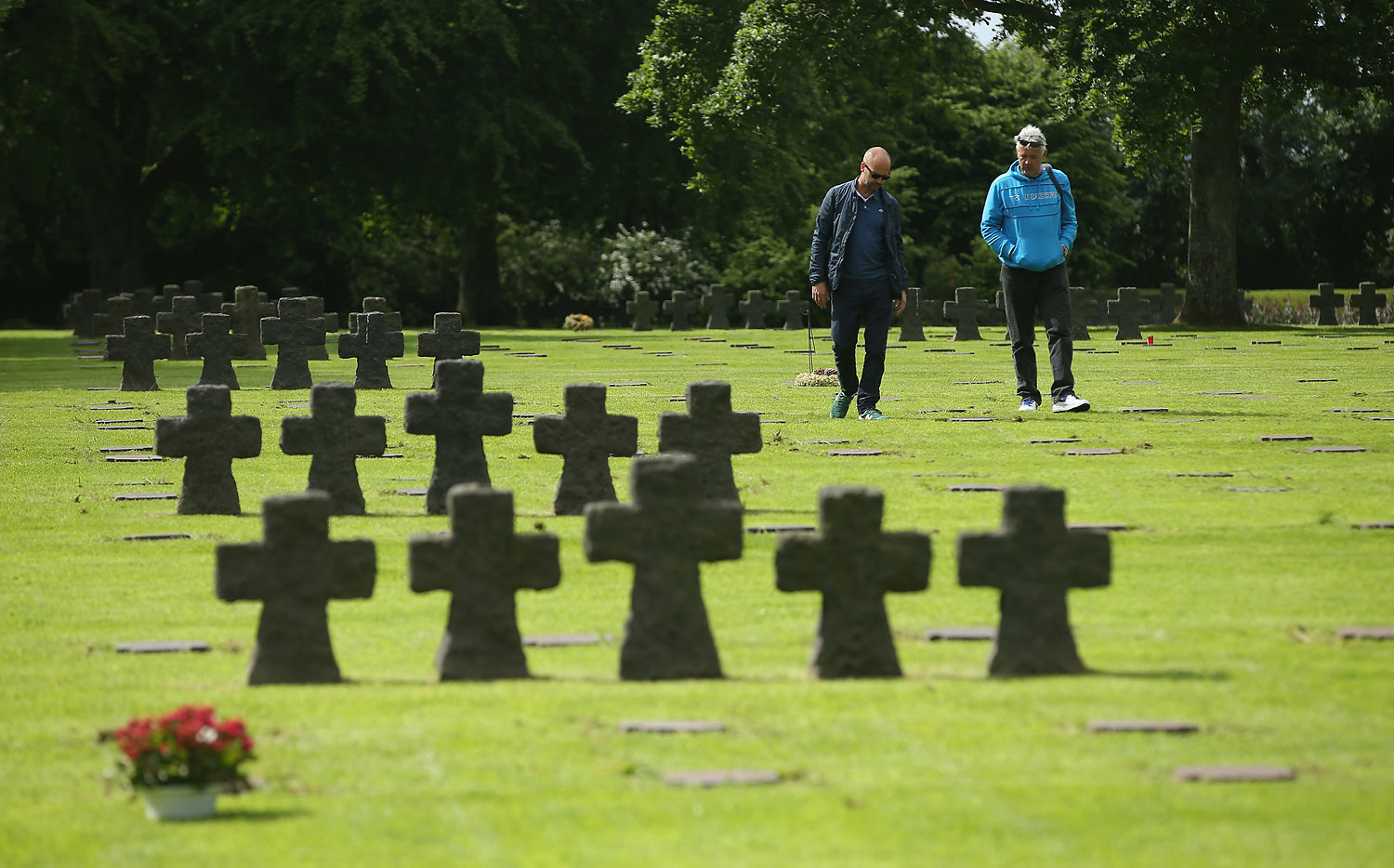
It may surprise the many Americans who have arrived in Normandy in France this week to commemorate the 70th anniversary of the D-Day landings, but the largest burial place here is not, in fact, the iconic U.S. war cemetery in Colleville-sur-Mer about 10 miles from here. That site’s forest of sunlit, erect white crosses in perfectly symmetrical rows marks the graves of more than 9,387 Americans, memorialized for later generations in Hollywood movies, including the closing scene of the Tom Hanks hit, Saving Private Ryan.
Instead, among the many cemeteries for the 100,000 or so soldiers killed in the mammoth seaborne invasion on June 6, 1944 known as D-Day, and the three-month Battle for Normandy that followed, the biggest number of graves by far honor 21,222 soldiers who fought on the losing side: The Germans.
For many modern Europeans, the well-tended cemetery seems to symbolize a unified continent—a sign that old enemies are now allies within the 28-nation E.U., ironically, with the strongest and biggest nation being Germany. And yet, it was only in 2004 that a German leader, then Gerhard Schroeder, wasfirst invited to attend the D-Day anniversary ceremonies. This year, Chancellor Angela Merkel will attend Friday’s international ceremony for 17 world leaders, including President Barack Obama.
But unlike Obama, who will lay a wreath at the U.S. cemetery, Merkel is not scheduled to visit the graves of her countrymen who died fighting for Normandy. And unlike the U.S., British and Canadian war cemeteries, whose funding comes from independent commissions of those governments, this one is maintained through voluntary donations under a private German association.
On Wednesday, hundreds of visitors—American and British World War II veterans, and yes, some Germans too—walked through the stone arch of the German cemetery, and into the sweeping manicured lawns of the graveyard. There, they stood almost speechless, taking in the shocking magnitude of casualties, as they gazed at the dark-brown tombstones embedded in the grass. Many seemed almost overwhelmed by the crushing sense of death, aware that Germany in the late 1940s—bankrupt, and morally destroyed—did not choose to bring their soldiers’ bodies home.
“There is a really different air about this place, somber,” said U.S. Navy veteran, John Kummer, 89, of Colombia, S.C., whose boat landed on the beach in Normandy as a gunner’s mate third class, on the U.S.S. LCI 502, on the morning of June 6, 1944, in the midst of a “chaotic, noisy, scary day.”
Like almost every veteran interviewed on Wednesday, Kummer said he felt no animosity to those who he’d fought against, regarding them as victims of Adolph Hitler’s dictatorship, rather than as supporters of the Nazis. In the cemetery, he felt deeply moved by the gravestones, often showing the dead to be just teenagers. Many, never identified, are identified only as “a German soldier.” “There was never a personal face on the enemy,” Kummer said. “It was Hitler we were fighting.”
And yet, even decades on, the brutal fighting in Normandy still seems intensely personal, especially this week. The narrow roads of these stone villages are crowded with World War II-era Jeeps driven by local war enthusiasts. Excited local children wave U.S. flags at village ceremonies, even while singing the French anthem, “La Marseillaise.” And signs are splashed across the storefronts proclaiming the American heroes, who have arrived, many in wheelchairs, in what all realize is the world’s last glimpse of the D-Day generation. “Merci a nos liberateurs!” or thank you our liberators, reads a sign, typical of the area, in La Cambe village, near the German cemetery.
But Germans visitors say their presence in Normandy is far more complicated. The D-Day invasion—the biggest seaborne wartime operation in modern history—rescued France from Nazism, and ended the calamitous war, which left millions dead and much of Western Europe in economic and physical ruin. “We are not proud of this,” said Arnd Gath, 45, from Frankfurt, as he walked across the German cemetery with two friends. Gath, whose grandfathers both fought in Hitler’s army (though not in Normandy) said he had first visited Normandy for the 65th anniversary in 2009, but had felt some hostility. “When we went into the village we got nothing to eat,” he says. “They would not serve us.”
But even those who fought on the winning side have conflicted feelings about the battle for Normandy, which killed about 100,000 soldiers on both sides. Hobbling on his cane in the midst of the German cemetery on Wednesday, David Edwards, 89, a British D-Day veteran from south Wales, said it had “taken years” for him to feel at peace about the Germans who were killed during the fighting. With his grandson Chris Edwards’ arm around him, the older man burst into tears as he looked across the cemetery. His voice trembling, he said, “These German boys never want wanted to fight us, any more than I wanted to fight them.”
The cemetery’s French conservator, Lucien Tisserand, said Germany’s World War II veterans keep a low profile in Normandy, most opting not to visit during the week of D-Day, when soldiers from the U.S., Britain, Canada, New Zealand and others, regularly converge on the area. Tisserand, who’s taken care of the cemetery for 23 years, says he often comforts German visitors, who seem “uneasy” when confronted by the memories of their grandparents’ war record.
His other task, he says, is explaining to European children—raised on a united continent, with a common currency—how World War II came about. “They ask me, ‘why did people hate each other?'” Tisserand says. “They just cannot understand it.”
More Must-Reads from TIME
- How Donald Trump Won
- The Best Inventions of 2024
- Why Sleep Is the Key to Living Longer
- How to Break 8 Toxic Communication Habits
- Nicola Coughlan Bet on Herself—And Won
- What It’s Like to Have Long COVID As a Kid
- 22 Essential Works of Indigenous Cinema
- Meet TIME's Newest Class of Next Generation Leaders
Contact us at letters@time.com